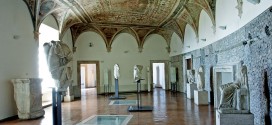At the end of the 2nd century BC a new sensitive rebirth of Praeneste was noticed, a period of great prosperity and wealth, documented mainly by impressive and monumental urban restoration of public buildings of civil and sacred character.
The Prenestins in fact, like citizens of many other small centers of Latium region took advantage of Rome’s wars in the East, and developed intense and prosperous merchant activity with those areas of Mediterranean, based substantially on slave trade, which lasted for nearly a century and was the source of a considerable and sudden enrichment.
At Delos, which was the largest slave market in the Mediterranean, where according to the greek geographer Strabo were sold up to ten thousand men a day, the inscriptions testify the economic participation of people of Praeneste in the construction of the monumental Agora known as Agora of Italics. This consistent growth of capital brought about the creation of new construction or reconstruction in the monumental forms of the main buildings and profoundly transformed the urban look.
According to habits of that time the richest prenestine families needed to participate in construction of buildings by paying donations expressing generosity towards the community. Paying out-of-Pocket public utility buildings, was a sign of wealth and power, but also a good means of pressure on public opinion and political propaganda, to those families. The most impressive of these interventions is the building complex of the sanctuary of Fortuna Primigenia rebuilt in magnificent Hellenistic forms still partially visible, but it also involved the ancient city overall. Monumental buildings were built and many of the existing ones were changed profoundly.
We know from sources that at the beginning of the 1st century BC, after the social war, the city gained Roman citizenship and turned into municipality. During the civil war between Marius and Silla, city took the side of Marius. A striking piece of Appian tells the story of Praeneste during those years, when it sheltered the son of Mario, Marius the younger, after the defeat of Sacriportum (82. BC). Unable to find refuge after the defeat of the military forces that had to rescue him, imagining himself closed in the besieged city, he committed suicide. Sulla retaliated with ferocity to all cities that had protected his enemy, massacring all male prenestin adults. This story findes its amazing match in the inscriptions that survived, many of them gathered at the Museum, inasmach as names of the most eminent prenestine families, known from Cippo (memorial stones) from average Republican necropolis and from public or sacred inscriptions of the city, are no longer attested after 82 BC. Almost all magistrates elected after that date have names that until then were never found engraved on inscriptions of the city. That is probably the sign that they were members of the military colony that Silla setteled at Praeneste after these events. Soon the settlers had to sell their fertile properties, and few years later Cicero states that the land of Praeneste was in hands of few people.
 Archeopalestrina Percorso archeologico di Palestrina, l'antica Praeneste
Archeopalestrina Percorso archeologico di Palestrina, l'antica Praeneste

